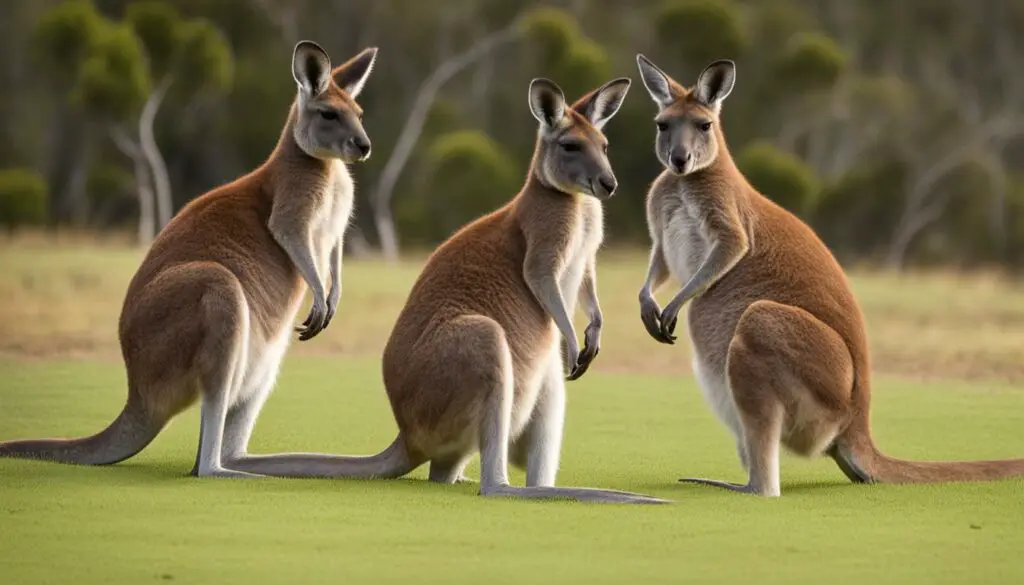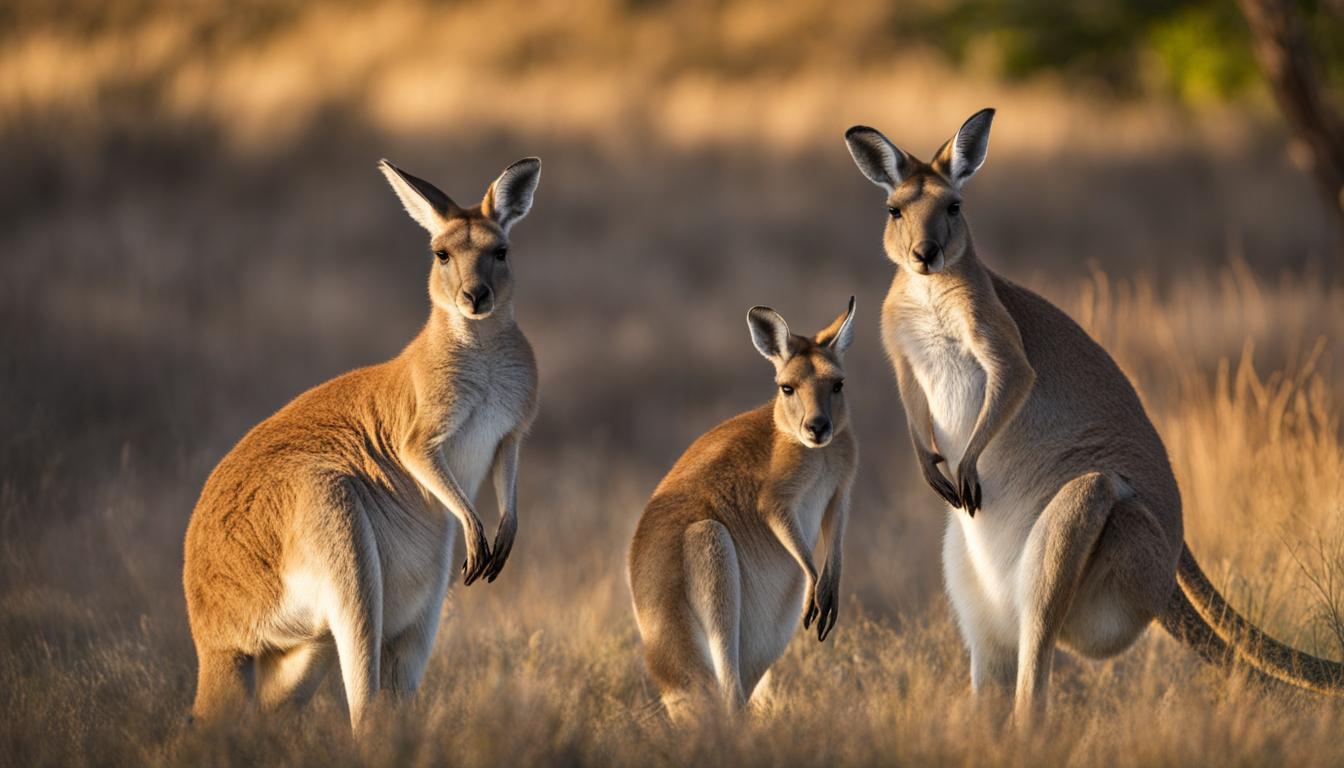Kangaroo social behavior and community interactions are fascinating to observe in the wild. These unique creatures exhibit a range of behaviors that allow them to communicate and interact with one another. Through the study of kangaroo behavior, researchers have made surprising discoveries about their intelligence and ability to communicate not only with each other but even with humans. Understanding how kangaroos interact in their natural habitat has important implications for their conservation and the way we should treat these remarkable animals.
Communication in Kangaroos
Kangaroos, known for their unique hopping locomotion, also have a complex system of communication. Through various behaviors and vocalizations, they interact with each other and maintain social structure within their groups. Understanding kangaroo communication provides valuable insights into their social dynamics, group hierarchies, and overall behavior.
One prominent form of communication among kangaroos is the stomping of hind legs. By rhythmically thumping their hind legs on the ground, they signal potential danger to other members of their group. This behavioral display serves as an alarm, alerting kangaroos to the presence of predators or other threats. It’s fascinating to observe how this communication method helps maintain group cohesion and ensures the safety of the collective.
Male kangaroos, known as bucks, also engage in vocalizations to establish their position within the social hierarchy. They produce distinct coughing or grumbling sounds to display submissiveness or obedience to higher-ranking males. This hierarchy is essential for maintaining order and minimizing physical confrontations within kangaroo mobs.
| Communication Methods | Description |
|---|---|
| Hind Leg Stomping | A rhythmic thumping of hind legs on the ground, signaling danger or alerting other kangaroos. |
| Male Vocalizations | Coughing or grumbling sounds used by male kangaroos to establish their position in the social hierarchy. |
| Female Vocalizations | Distinct clucking or clicking noises produced by female kangaroos for communication with their joeys. |
| Aggressive Vocalizations | Growling and screaming sounds during aggressive encounters between kangaroos. |
Female kangaroos, or does, have their own unique vocalizations to communicate with their offspring, known as joeys. They use clucking or clicking noises to convey messages and maintain contact with their young. These distinct vocalizations help in nurturing and ensuring the well-being of the next generation of kangaroos.
Overall, the communication methods employed by kangaroos provide a glimpse into their social structure, group dynamics, and hierarchy. From stomping their hind legs to vocalizing their positions, these behaviors contribute to the cohesion and survival of kangaroo mobs. By understanding and appreciating these communication methods, we can gain a deeper appreciation for the complex social lives of these fascinating creatures.
Kangaroos use various behaviors and vocalizations to communicate with each other. Hind leg stomping, male vocalizations, and female vocalizations are all important forms of communication in kangaroo social interactions. These signals help maintain group dynamics, establish hierarchies, and ensure the safety and well-being of the collective.
Social Interactions in Kangaroos
Kangaroos are highly social animals that engage in a variety of social interactions within their groups. These interactions play a crucial role in maintaining the cohesion and well-being of kangaroo mobs. One important aspect of kangaroo socialization is grooming, where individuals engage in mutual cleaning and rubbing of each other’s bodies. This behavior not only helps maintain hygiene but also serves as a form of bonding among group members.
In addition to grooming, kangaroos also engage in play behavior, which involves activities such as chasing, jumping, and wrestling. This playful interaction helps them establish social bonds and develop important social skills. Play is particularly common among young kangaroos, but adults also participate, reinforcing social relationships within the group.
Kangaroos also exhibit social bonding through physical contact, such as nuzzling and hugging. These behaviors create a sense of closeness and unity within the group. Social bonding is essential for kangaroos as it promotes cooperation, communication, and a sense of security among mob members.
Table: Types of Social Interactions in Kangaroos
| Behavior | Description |
|---|---|
| Grooming | Mutual cleaning and rubbing of bodies to maintain hygiene and establish bonds |
| Play Behavior | Engaging in playful activities such as chasing, jumping, and wrestling to strengthen social relationships |
| Physical Contact | Nuzzling and hugging to create a sense of closeness and unity within the group |
The social interactions observed in kangaroos highlight their complex social structure and the importance of social bonding among group members. Understanding and appreciating these behaviors can contribute to the conservation and well-being of kangaroo populations in the wild.
Kangaroo Activity Patterns
Kangaroos have fascinating activity patterns that vary depending on the time of day and environmental conditions. While they are primarily nocturnal animals, they can also be active during periods of low light and even in bright sunlight. This unique behavior allows them to adapt to their surroundings and regulate their body temperature effectively.
During the nighttime, when it is dark or the light intensity is low, kangaroos are most active. They utilize their excellent night vision to navigate their surroundings, forage for food, and engage in social interactions. This behavior helps them avoid predators and take advantage of the cooler temperatures that occur after sunset.
However, it is not uncommon to spot kangaroos out in the open during the daytime as well. They are known to bask in the sun, especially during the cooler months, to warm up their bodies. This behavior is crucial for thermoregulation, as it helps them maintain their body heat and energy levels.
| Activity | Time of Day |
|---|---|
| Nocturnal activity | Nighttime and periods of low light |
| Diurnal activity | Daytime, especially in cooler temperatures |
In addition to their activity patterns, kangaroos have a unique behavior to cope with hot weather. They often lick their forearms, which promotes heat loss through evaporation. This behavior helps them cool down and maintain their body temperature within a comfortable range. It’s an amazing adaptation that demonstrates their ability to survive in harsh environmental conditions.
Understanding the activity rhythms and behavior of kangaroos is essential for their conservation and management. By respecting their natural patterns and providing suitable habitats that allow for their nocturnal and diurnal activities, we can contribute to the well-being and thriving of these fascinating creatures in the wild.

Kangaroo Mob Dynamics
Kangaroos travel and feed in groups called “mobs,” which have a shifting composition. Mobs are not truly social, as individual members move independently. However, one member can alert the mob to potential threats by thumping its tail on the ground, triggering a wild rout where individuals scatter in different directions. This signaling behavior is a defense mechanism against predators. Kangaroos also use their strong arms and hind feet to defend themselves by biting, kicking, and boxing. Their agility and unique fighting tactics make them formidable opponents.
To better understand the dynamics of kangaroo mobs, let’s take a closer look at their composition. Mobs typically consist of 10 to 100 individuals, with a dominant male as the leader. This male, also known as the alpha male, maintains his position through displays of strength and dominance. While the alpha male is responsible for protecting the mob, other males may challenge his leadership in attempts to gain control.
Within the mob, there is a hierarchy that determines the social standing of each individual. Females have a dominant position in the hierarchy, followed by subordinate females, non-breeding males, and finally, the alpha male. This hierarchy influences the interactions and behaviors within the mob, with the dominant individuals having greater access to resources and mates.
| Rank | Description |
|---|---|
| Alpha Male | The dominant male who leads the mob and protects its members. |
| Dominant Females | Females with priority access to resources and mates. |
| Subordinate Females | Females with lower social standing, still have access to resources but may have limited mating opportunities. |
| Non-breeding Males | Males who do not hold a dominant position and have limited access to resources and mates. |
In summary, kangaroo mobs are characterized by their shifting composition and defense mechanisms. Alert signals and physical fighting techniques are employed for protection against predators and to maintain individual safety within the group. Understanding the dynamics of kangaroo mobs provides insights into their social behavior and the complex interactions that shape their survival strategies.
The Hierarchy within Kangaroo Mobs
Within kangaroo mobs, a clear social hierarchy exists, influencing the interactions and behavior of individual members. The hierarchy is determined by the social standing of each kangaroo, with dominant females holding the highest position. They have priority access to resources and mates, ensuring their reproductive success and the overall stability of the mob.
Following dominant females, subordinate females occupy the next level in the hierarchy. These females have lower social standing but still have access to resources and potential mating opportunities. Non-breeding males come next, with limited access to resources and mates. They often have to compete with each other for higher social status within the mob.
The alpha male, the dominant male in the mob, holds the lowest position in the hierarchy. While he leads and protects the mob, his social standing is lower than that of the dominant females. The alpha male’s position can be challenged by other males seeking to gain control and become the new leader of the mob.
This hierarchy plays a crucial role in the social dynamics of kangaroo mobs, impacting their feeding behavior, mating strategies, and overall cohesion as a group. By understanding the hierarchy within kangaroo mobs, we gain valuable insights into their social structure and the complex interactions that shape their behavior.
Human Impact on Kangaroo Social Behavior
The interaction between humans and kangaroos has a significant impact on the social behavior of these fascinating creatures. Through various activities and interventions, humans have both positive and negative effects on kangaroo populations and their social dynamics.
Table: Kangaroo Population Control Methods
| Methods | Description |
|---|---|
| Culling | Annual culling efforts are carried out to control the kangaroo population, especially in areas where they have become a nuisance or pose a threat to agricultural practices. |
| Habitat modification | The clearing of vegetation by humans, such as European pastoralists, has created open habitats suitable for kangaroo grazing, allowing their populations to thrive. |
The kangaroo-human interaction also plays a role in shaping their social behavior. Kangaroos have shown an ability to adapt their communication with humans, indicating a level of socialization. This interaction often occurs in captive settings, where kangaroos may display requests for help or engage in playful behaviors.
However, it is important to consider the cognitive abilities and social needs of kangaroos to ensure their well-being and conservation. Understanding how human activities can impact kangaroo populations and their social dynamics is crucial for implementing effective conservation measures. By valuing and preserving their social bonds and natural habitats, we can promote the survival and overall welfare of kangaroos in the wild.
“Kangaroos have an incredible ability to adapt their communication with humans, which indicates their social intelligence and emotional capabilities.”
Conclusion
Kangaroos exhibit complex social behavior and communication, displaying intelligence and adaptation to their environment. Their ability to make requests for help from humans highlights their higher level of intelligence than previously assumed. These fascinating creatures use a variety of behaviors and vocalizations to communicate with each other, maintaining group dynamics and hierarchy within kangaroo mobs. Through social bonding, grooming, and play behavior, kangaroos strengthen their relationships and contribute to the overall well-being and cohesion of their groups.
Kangaroos have adapted to their environment by developing unique activity patterns and behaviors. They are primarily active at night and during periods of low light, but can also be seen out in the open during bright sunlight. When faced with hot weather, kangaroos have a fascinating behavior of licking their forearms to promote heat loss through evaporation, helping them regulate their body temperature effectively.
Understanding the social dynamics and behavior of kangaroos is crucial for their conservation. Human activities have both positive and negative impacts on kangaroo social behavior. While controlled burns and vegetation clearing have benefited kangaroo populations, annual culling efforts have become necessary due to population growth. By valuing and preserving their social bonds, as well as considering their cognitive abilities, we can contribute to better treatment and conservation efforts, ensuring the well-being and survival of kangaroo populations in the wild.
Do Kangaroos Use Boxing as a Form of Social Interaction in the Wild?
Kangaroos are known for their social boxing interactions, especially among males. Boxing is often used as a way to establish dominance and assert social hierarchy within kangaroo communities. While it may appear aggressive, it is actually a form of social interaction and helps maintain balance within the group.
What are some examples of kangaroo interactions in the wild?
Kangaroos exhibit various interesting behaviors in the wild. They use their strong tails for balance and leaning on for support. When hopping, kangaroos can reach up to 25 feet in a single jump. They also communicate through vocal sounds and have great hearing abilities. These fun facts about kangaroos highlight their unique behaviors.
FAQ
How do kangaroos interact with each other in the wild?
Kangaroos interact with each other through various behaviors and vocalizations, such as stomping their hind legs to alert others of danger and using distinct noises to communicate with their joeys.
What is the communication structure among kangaroos?
Kangaroos have a social structure that includes group dynamics and hierarchy. They use behaviors and vocalizations to maintain group cohesion and hierarchy within their mobs.
How do kangaroos socially bond with each other?
Kangaroos engage in social bonding through grooming, rubbing each other’s bodies, and playing together. These social interactions contribute to the overall well-being of kangaroo groups.
What are the activity patterns of kangaroos?
Kangaroos are primarily active at night and during periods of low light. However, they can also be found out in the open in bright sunlight. They have developed unique behaviors to regulate their body temperature, such as licking their forearms during hot weather.
How do kangaroo mobs function?
Kangaroo mobs are groups in which individual members move independently. However, members can alert the group to potential threats by thumping their tails on the ground, triggering a wild rout where individuals scatter in different directions.
What is the impact of humans on kangaroo social behavior?
Human activities have both positive and negative impacts on kangaroo social behavior. While some human actions, such as controlled burns and vegetation clearing, have benefited kangaroo populations, human presence has also led to population control efforts due to kangaroo overpopulation.
What is the importance of understanding kangaroo behavior for conservation?
Understanding kangaroo behavior and social dynamics is crucial for promoting better conservation practices and treatment of these creatures. By valuing and preserving their social bonds, we can contribute to the well-being and survival of kangaroo populations in the wild.











